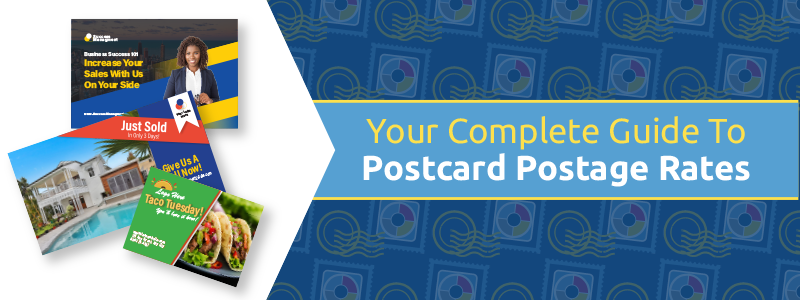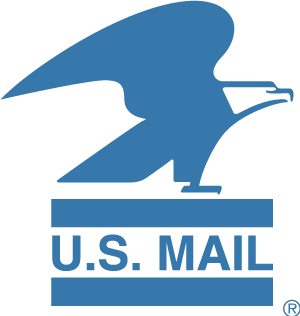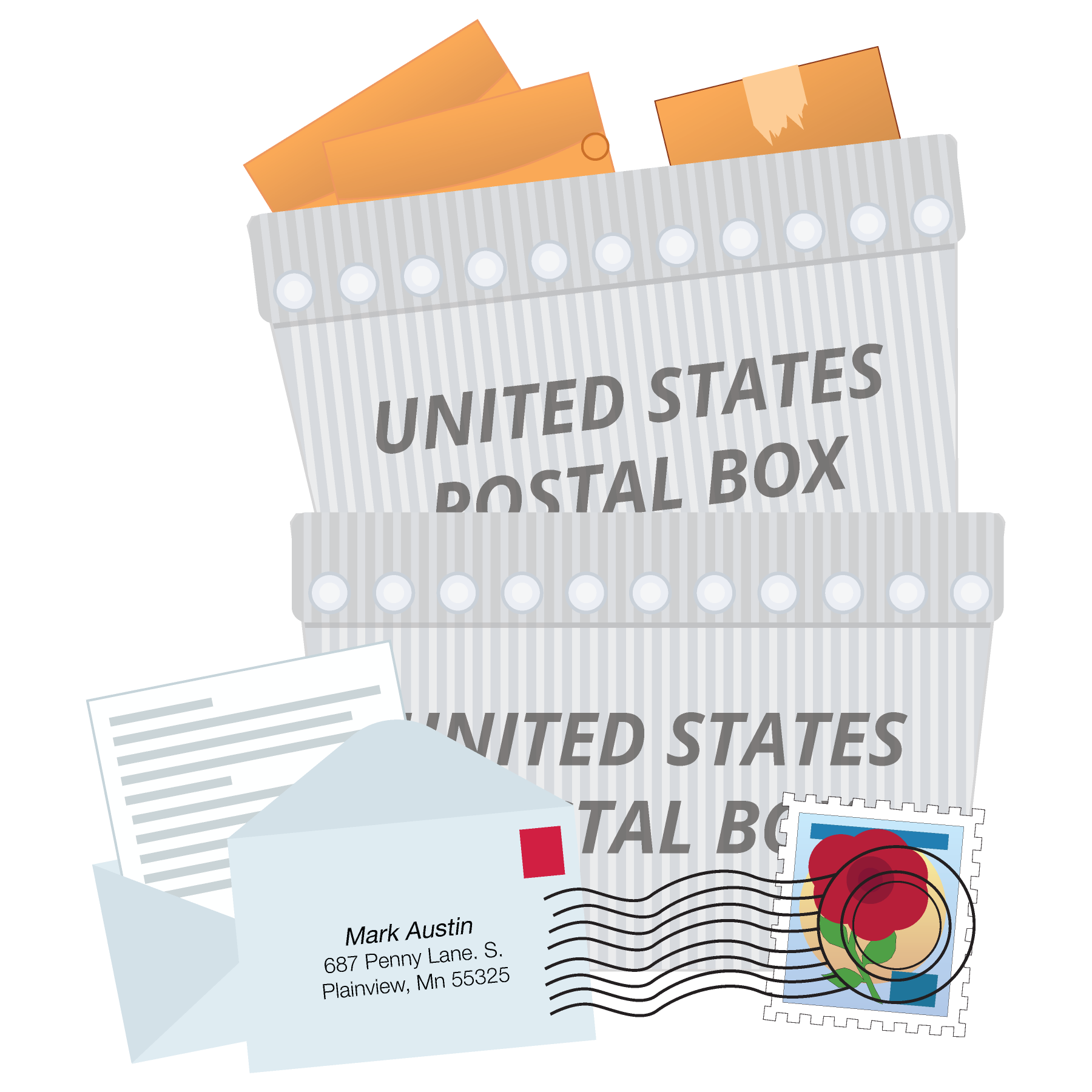
When it comes to the final cost of postcard mailing, a few factors will determine the overall price, including the postage you will need to pay per piece to the United States Postal Service.
So, what are the factors about your postcard project that will determine the final postage cost?
Essentially, the postage will be calculated by the class of mail, postcard size and weight, and the quantity you're mailing. And luckily, we have the details so you can determine the postcard postage rates for your project.
Classes of Mail
The USPS offers several “Classes” of mail that you can use for a mailing project.
Each class of mail offers its own set of benefits, requirements, and pricing, and below are some basic points about each class to know that can help you select the right option for you.
First Class Mail

First Class is the type of mail that most people have heard of. When you’re putting a letter in your mailbox with a stamp, you’re using a kind of First Class Mail.
However, this is also available when sending out bulk mail. The main aspects of First Class Mail are:
Speed – The post office treats First Class Mail as the most important. As a result, mail pieces sent out with this class are delivered to recipients very quickly, often within 1- 5 business days.
Cost – First Class is the most expensive, with a mailing rate ranging from $0.40-$1.16.
Quantity Requirements – First Class Mail offers a non-presort option, which means you can mail as few items as you’d like. However, to receive “Presort” pricing, you must mail at least 500 pieces.
Standard Mail (AKA Marketing Mail)
Standard Mail (also known as Marketing Mail) is most commonly used for bulk mailing because it is cheaper per piece than First Class Mail.
With the lower cost, the post office gives Standard Mail a lower priority than First Class, so delivery times are longer. Unless you have a specific deadline or a fast-approaching event, you can take advantage of this type of mail and save a considerable amount of money.

Speed – The USPS provides a range of 3-21 days for delivery times.
Cost – Standard Mail is significantly less expensive than First Class Mail with the cost ranging from $0.20-$0.40.
Quantity Requirements – All mail pieces sent out as Standard mail must be presorted (described below), and the minimum quantity is 200.
Nonprofit Options – If you are a nonprofit (as verified by the IRS), you can mail using special Nonprofit Standard rates, which offer a significant discount.
Every Door Direct Mail (EDDM)
Every Door Direct Mail is a type of mail that allows you to send postcards to entire postal routes without using a mailing list.
Speed – The USPS provides a range of 2-15 days for delivery times.
Cost – EDDM is cheaper than regular Standard Mail, at around $0.20 per piece, making it a cost-effective option.
Quantity Requirements – For EDDM, unless your selected ZIP code contains less than 200 addresses, you must mail at least 200 postcards. In addition, you can't send more than 5,000 mail pieces per day using any 5-digit ZIP code.
Presorted Mail Versus Non-Presorted Mail
While technically not a mailing class, a “Presort” rate is available for bulk mail. “Presorting” means that you or your direct mail provider will organize your mail by destination ZIP codes to make it easier for the Postal Service to get your mail to its destination. In return, you receive lower postage rates by making the post office's job easier.

To make presorting worth it, you do have to mail a high enough quantity of mail. The minimum quantities are 500 for First Class Presort and 200 for Standard Presort.
Partnering with a mail house or full-service print and mailing company is the best way to take advantage of a presorted mailing as they have the special mail software and permit with the USPS.
Commingled Postcards
Also, not a class of mail but rather a service offered by some print and direct mail providers, Postcard Commingling takes advantage of Standard Presort postage rates, but you can send out as few 6"x9" postcards as you would like.
It works by mailing your postcards with other companies’ mailings, so if you have 20 postcards and another company has 180, you can both take advantage of Standard Presort rates even without meeting the minimum quantity.
Speed – Commingled postcards take advantage of Standard Mail, resulting in a delivery time of 2 to 15 business days.
Cost – Postage rates are equivalent to Standard Presort Mail. Plus, you can print and mail a single postcard for about $1.
Quantity Requirements – There is no minimum quantity needed for commingled postcards. As long as you have at least 1 6”x9” postcard, you can commingle it.
Postcard Sizes
The postcard size you choose will directly determine the class of mail you can choose. The most common sizes range from 4"x6" up to 6"x11", with custom sizes also available. Postcard sizes are categorized into two categories that influence postage costs: standard and oversized postcards.
Standard postcards include "4x6", 4.25"x6", and 5"x7". These sizes are considered "Cards" and have a lower mailing rate of around $0.20 to $0.40.
Oversized postcards include 5.5"x8.5", 6"x9", 6.25"x9", and 6"x11". These sizes are considered "Letters" by the USPS and have a slightly higher mailing rate of around $0.40 to $0.60.

Suppose you’re mailing 6.25”x9” or 6”x11” postcards. In that case, you’re reaching sizes eligible for Every Door Direct Mail (or EDDM), an entirely different method of targeting audiences, as there is no longer a list of names or addresses needed to which your postcards are mailed. Instead, it uses mailing routes.

Postcard Quantities
There are no minimums for First Class Non-Presort, but postage costs will be much higher. For First Class Presort, you must mail at least 500 postcards. You must mail at least 200 postcards for Standard Presort Mail and Nonprofit.
Suppose you have fewer than 200 addresses you want to mail to. In that case, we recommend adding a few more and ordering at least 200 postcards to reach the minimum so you can significantly lower per-piece postage costs. Or we recommend choosing a 6"x9" postcard to qualify for Postcard Commingling so that even if you don’t meet the minimum for First Class or Standard Presort, you still benefit from bulk mail discounts.
For tips on how to save money on your postcard postage costs, check out our blog “How to Reduce Direct Mail Postage Costs.”
Postcard Postage FAQ
How Many Stamps Should I Use on My Mailed Postcard?
One stamp is more than enough for standard postcard sizes to cover your postage costs if you're mailing them domestically. However, for larger postcard sizes, a second stamp may be needed.
Do I Have to Use a Stamp on My Postcard?
Stamps are usually reserved for a single postcard being mailed. In direct mail marketing or high-volume mailings, stamps aren't typically used. Instead, a permit imprint indicia is the most common postage method. Indicias containing the mailing information are printed directly onto each postcard by your mail provider, signifying that postage was paid for.
How Much Does Postcard Postage Cost?

The average cost for a standard postcard stamp is $0.53 to $0.68. Using a permit imprint, the postage cost could be anywhere from $0.19 to $0.68, depending on the size and weight of the postcard and the class of mail.
Generally, postcards 6 inches long by 4¼ inches high by .016 inches thick or smaller will cost you around $0.40 or one postcard stamp to mail anywhere in the US.
If you have postcards larger than that but smaller than 11½ inches long by 6-1/8 inches by ¼ inch thick, they will cost you around $0.58.
Prices may vary depending on where you're mailing to and from. You can use the USPS postage price calculator to get an idea of how much your postcard postage will cost.
Do I Need an Envelope for My Postcard?
You do not need an envelope to mail postcards. If your postcard is thick enough, we recommend not using an envelope so that your message is seen and engaged immediately rather than having the recipient open an envelope to view it.
What are The Design Requirements for My Postcard?

Your postcard design is good to go as long as you leave a blank space, at least 4"x2.25", for the mailing information, including address and mailing indicia. This empty area is typically in the bottom right on the back of the postcard. Use a postcard design template to help ensure your postcard meets print and mailing requirements.
Do I Need a Return Address on My Postcard?
Unless a return service is requested, you do not need to include a return address on your postcard. However, if the post office can't deliver your postcard for whatever reason, they won't be able to return it to you.
Which Postcard Size Should I use?
The larger the postcard, the larger the impact. However, a smaller postcard might be perfect, depending on your message and budget. For example, a 4”x6” is perfect for a thank you note, while a 6”x11” is perfect for promoting a grand opening.
In addition, if you are using Postcard Commingling, you must use a 6x9 postcard, and for EDDM, you must use a 6.25”x9” or a 6”x11” postcard.
Ready to Get Started on Your Postcard Project?
Now that you have a good understanding of the postcard postage rates, you’re ready to get started on your postcard mailing!
At Kingston Printing, we don't just print postcards. Our in-house mailing center can handle all your mailing and postage needs from beginning to end, and we will never charge you more than the post office would.
If you're ready to get started on your postcard mailing, request a free quote today!
If you have any questions or are looking for guidance in choosing the best options for your goals and budget, please don’t hesitate to reach out! Our direct mail experts are here to help.
Get A Quote Today!









